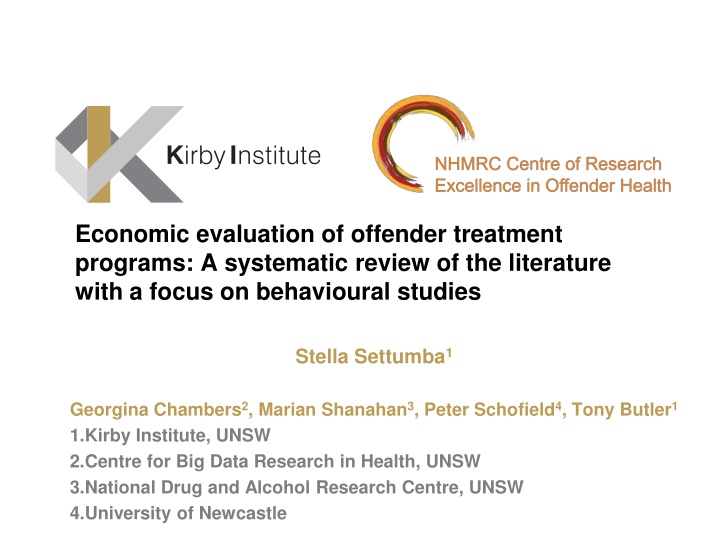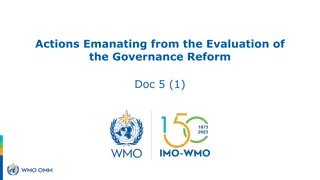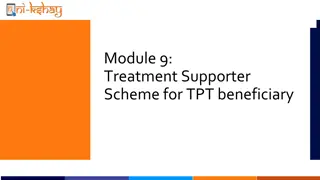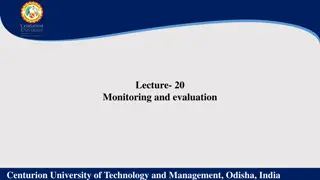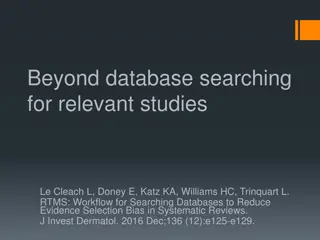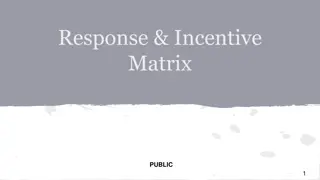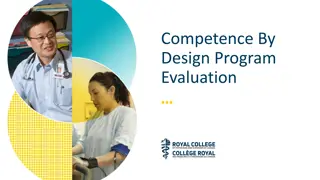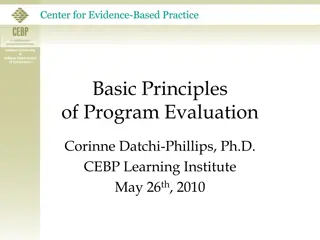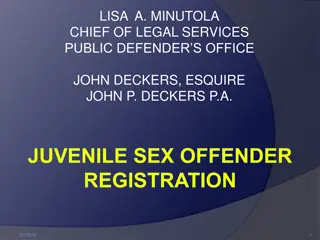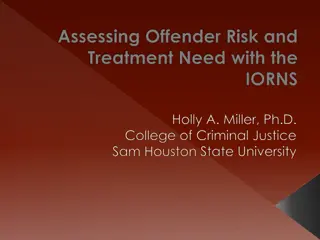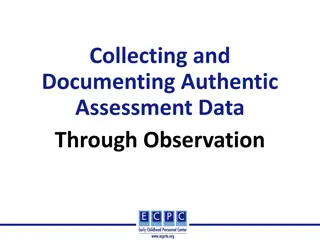Economic Evaluation of Offender Treatment Programs: A Systematic Review
This systematic review examines economic evaluations of offender treatment programs, focusing on behavioral studies. It covers world prisoner statistics, costs in the justice system, treatment programs, and the impact of recidivism on society. Highlighted are trends in prisoner populations, changes in global population totals, and recidivism rates.
Download Presentation

Please find below an Image/Link to download the presentation.
The content on the website is provided AS IS for your information and personal use only. It may not be sold, licensed, or shared on other websites without obtaining consent from the author.If you encounter any issues during the download, it is possible that the publisher has removed the file from their server.
You are allowed to download the files provided on this website for personal or commercial use, subject to the condition that they are used lawfully. All files are the property of their respective owners.
The content on the website is provided AS IS for your information and personal use only. It may not be sold, licensed, or shared on other websites without obtaining consent from the author.
E N D
Presentation Transcript
Economic evaluation of offender treatment programs: A systematic review of the literature with a focus on behavioural studies Stella Settumba1 Georgina Chambers2, Marian Shanahan3, Peter Schofield4, Tony Butler1 1.Kirby Institute, UNSW 2.Centre for Big Data Research in Health, UNSW 3.National Drug and Alcohol Research Centre, UNSW 4.University of Newcastle
Presentation Outline World prisoner statistics Costs in the justice system Treatment programs Economic evaluations of treatment programs Systematic Review
Prisoner population totals 2000 & 2015 10,000 10,357 9,000 8,664 8,000 World 7,000 6,000 Africa Americas Asia Europe Oceania Thousands 3,898 3,781 5,000 3,024 2,690 4,000 2,014 3,000 1,585 1,039 903 2,000 1,000 55 34 - 2000 2015 Source: World Prison Brief
Percentage change in global population totals 2000 - 2015 60% 50% 59% 40% 44% 29% 25% 41% 30% World 20% 18% 18% 17% 15% 20% Africa Americas Asia Europe Oceania 10% 3% 0% -10% -21% -20% -30% % change in general population % change in prison population Source: World Prison Brief
Prisoner statistics: Australia Average daily prisoner population 39,152 40,000 38,000 36,000 33,791 34,000 32,000 29,700 29,383 30,000 27,615 28,000 25,790 26,000 24,171 24,000 22,492 21,714 22,000 20,000 2000 2002 2004 2006 2008 2010 2012 2014 2016 - Total prisoner population increased by 80% between 2000 and 2016 (Higher than the 20% global increase) - Prisoner rate is 208 per 100,000 population Source: Australian Bureau of Statistics
Recidivism Recidivism is the relapse of criminal behaviour Globally, approximately 50% recidivism rate within 2 years Recidivism in Australia 60% 51% 50% 45% 44% 40% 33% 30% 20% 10% 0% 1999 - 2000 2004 - 2005 2009 - 2010 2014 - 2015 Source: Productivity Commission: Report on government
- Big offender population - Increasing recidivism rates - Large financial strain on society
What are the costs? Country Annual Judicial Expenditure Annual cost of crime (Million USD) (Million USD) USA 265,000 1,700,000 UK 12,000 91,000 Australia 12,000 51,000 Judicial Expenditure Police, Prosecutions, Courts, Corrections, other agencies. Costs of Crime Justice costs, victim costs, insurance, medical, lost output, intangible costs. Sources: USA Bureau of statistics (2013), Foundations and trends in microeconomics (2012), UK Min. of Justice (2015), Home Office UK (2000), ROGs (2016), AIC (2011)
Costs in Australia (AUD) 16 15.3 14 12.3 12 Costs in Billions 10 8.3 8 6.4 6 3.7 3.3 4 2.0 1.3 2 0 1999 - 2000 2004 - 2005 2009 - 2010 2014 - 2015 Judicial costs Corrective services costs Source: Report on Government Services:
Judicial system and crime costs are substantial. Economic evaluation studies of programs that reduce offending are needed to efficiently guide resource allocation.
Intervention programs for Offenders Corrective Services NSW lists at least 34 approved offender behaviour change programs (Compendium of Offender Behaviour Change Programs in New South Wales, 2016)
Intervention programs Review 1945 -1967 (Martinson.1974, Lipton et al. 1975) Nothing works Review 1985 2013 (Craig et al. 2013) What works What is cost effective This study
Objective of this review To assess the peer-reviewed literature on economic evaluations of interventions for offenders a) What is the scope and quality of economic evaluation studies? b) Were the interventions an efficient use of resources?
Methods Systematic Review of literature 2003 2016 using PRISMA guidelines Inclusion criteria: Full economic evaluations CEA, CUA, CBA, CMA Both costs and effects Intervention and comparison group Intervention group were offenders/prisoners English Applied a recommended checklist for quality assessment: Drummond checklist Synthesis of the results of the economic evaluations
What is an Economic Evaluation? Economic evaluation is about determining whether an intervention is an efficient use of society's resources and can be defined as the comparative analysis of alternative courses of action in terms of both their costs and consequences (Drummond et al. 1987). Perspectives: Provider Perspective Only includes costs incurred by the provider of treatment services e.g. Criminal Justice, Intervention provider Societal Perspective Broader costs regardless of who meets them e.g. personal, general population, victim costs
Types of Economic Evaluations Type of Analysis Numerator (Costs) Denominator (Outcomes) Results Least cost alternative Cost- minimization $ - (Proven equal outcome) Cost per unit of outcome e.g. cost per drug free day Cost- effectiveness $ Health outcome in natural unit e.g. number of lives saved, number of crimes averted, number of drug free days Cost per unit of outcome e.g. Cost per QALY Cost-utility $ Quality of life outcome e.g. QALY, DALY Cost-benefit $ $ Net benefit ($) Cost: Benefit ratio
Literature search Multiple databases Embase, Medline, Cinahl, Cochrane, Tufts registry, Other citation databases Range of search streams Mesh terms/Subject headings Key terms Prisoners, inmates, offenders, incarcerated, criminal, delinquent, public offenders Economic evaluation, cost-benefit, cost-effectiveness, cost-utility, cost analysis, cost, Total number of retrieved articles 802
PRISMA flow chart Identification Records identified through database searching (n = 788) Additional records identified through other sources (n = 14) Records after duplicates removed (n = 661) Records excluded after review of titles and abstracts. (n = 573) Screening Records screened (n = 88) Full-text articles excluded, after examination of inclusion criteria (n = 46) Eligibility Full text articles included in qualitative synthesis (n = 36) Included Infectious disease Interventions (n = 18) Behavioural Interventions (n =17) Other Interventions (n = 1)
Results: Only 17 peer reviewed publications globally Number of Publications by country AUS, 3 UK, 1 USA, 13 0 1 2 3 4 5 6 7 8 9 10 11 12 13 14
Focus of the 17 studies Sexual Abuse, 1 Substance Abuse, 12 Violence, 3 Personality disorder, 1
Intervention groups 7 6 6 6 Number of Publications 5 5 4 3 2 1 0 0 Men Men & Women Women Juveniles Adults
Assessment of Quality of publications Standard checklist for critical appraisal Drummond et al, Methods for economic evaluation of health care programs; 2003, 2016 10 Major headings 33 Item checklist Criteria (Yes, No, Not applicable, Not sure) Score (% number of Yes scores out of all applicable
Quality Assessment Presentation & discussion of results 82% Allowance made for uncertainity 65% Incremental analysis performed 82% Adjustment for differential timing 44% Costs & consequences valued credibly 71% Costs & consequences measured accurately 53% All costs & consequences identified 24% Effectiveness established 94% Comprehensive description of alternatives 100% Well defined question 88%
Quality Assessment Presentation & discussion of results 82% Allowance made for uncertainity 65% Incremental analysis performed 82% Adjustment for differential timing 44% Costs & consequences valued credibly 71% Costs & consequences measured accurately 53% All costs & consequences identified 24% 94% Effectiveness established Comprehensive description of alternatives 100% Well defined question 88%
Quality Assessment Presentation & discussion of results 82% Allowance made for uncertainity 65% Incremental analysis performed 82% Adjustment for differential timing 44% Costs & consequences valued credibly 71% Costs & consequences measured accurately 53% All costs & consequences identified 24% Effectiveness established 94% Comprehensive description of alternatives 100% Well defined question 88%
Economic Evaluation results 7 Studies were Cost Benefit Studies 10 Studies were Cost Effectiveness Studies No CUA & CMA studies Wide variations in methods: - Costing perspectives - Follow-up period (6 months 5 years; 25 years for models) - Type of costs included - Outcome measures e.g. among substance abuse studies (Drug free days, re- incarceration during follow up, number of days incarcerated, Number of offences committed, etc)
Cost-Benefit Analysis Results 3 Substance Abuse Perspectives: 2 Societal, 1 provider Intervention group: 1 men, 1 men & women, 1 Juvenile Education & residential treatment vs education only Drug court vs probation & parole/ Incarceration MST vs IT 1 Sexual Abuse (Juveniles) Perspective: Societal MST vs IT 3 Violence (Juveniles) Perspectives: 2 societal, 1 provider Specialised mental health treatment vs usual treatment in corrective services MST vs IT MST vs IT (Longer follow up) Positive net benefit or a cost-benefit ratio < 1
Cost-Effectiveness Analysis Results 9 Substance Abuse, all provider perspective Intervention group: 3 men, 4 men & women, 2 Juvenile 5 were cost-effective In prison drug treatment + after care vs drug treatment alone (2 studies) Adult Drug court vs probation & parole/ Incarceration Juvenile Drug court + MST+ Contingency management vs Family court Post release opioid substitution therapy vs no treatment In prison drug treatment + after care (short) vs drug treatment alone Seamless probation vs traditional probation Motivational enhancement therapy vs Individual counselling (with and without contingency management) Prison methadone treatment vs no treatment
Cost-Effectiveness Analysis Results 1 Personality disorders Men Dangerous severe personality disorder program (CBT with Dialectical therapy) vs usual treatment Not Cost effective
Conclusions Few studies 11 cost-effective/net-benefit. We need more evaluated to inform policy on efficient use of resources Quality of studies needs to be improved Billions Spent Many programs Program Effectiveness established Economic Evaluations
Are you evaluating your programs? OPTION B OPTION A
